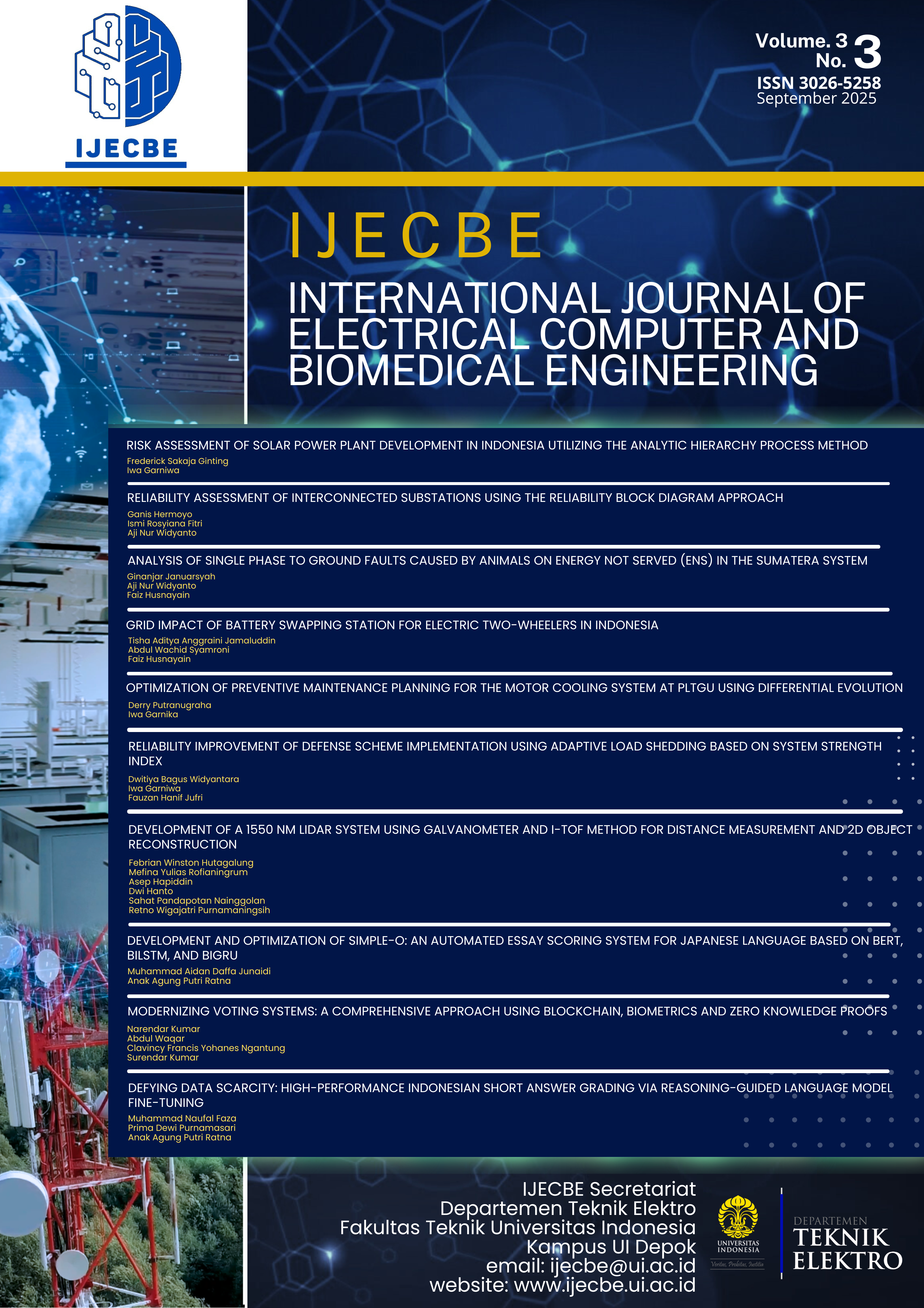Modernizing Voting Systems: A Comprehensive Approach Using Blockchain, Biometrics and Zero Knowledge Proofs
DOI:
https://doi.org/10.62146/ijecbe.v3i3.116Keywords:
Blockchain, Hyperledger Fabric, Chaincode, Electronic Voting Machine. ZKPs, Biometric featuresAbstract
This research article provides the design of an in-person and remote voting system, while at the same time ensuring the privacy of users that would guarantee openness, transparency, and at the same time fraud-free results. The aim is to solve various common problems associated with most conventional elections including fraud, vote manipulation, through adaptation of the usage of a safe, highly transparent decentralized logical Hyperledger Fabric-based system provided by blockchain implementation. The methodology in this article is to be implemented for the sheer reason of urgency needed in making a more secure and transparent system for voting, considering even the rising frauds in elections. The addition of Zero Knowledge Proof (ZKP) guarantees that votes are confident and correct, yet anonymous between a voter and their vote. Biometric identification makes the system resistant to double spending. This incorporation of technologies ensures there is privacy and immutability against the double
transactions, which, in turn, would be put in place as foundation for the future to be provided wherein every process in an election becomes safe and transparent. Innovation via creating a voting system to be trusted to meet today's demands and set standards for future electoral processes.
References
I. K. Hartono and D. L. Kusumastuti, “The Blockchain Conceptual Model to Prevents Fraud and Increase Transparency In The Presidential Election In Indonesia,” in 2023 IEEE 9th International Conference on Computing, Engineering and Design (ICCED), IEEE, 2023, pp. 1–6.
N. B. Al Barghuthi et al., “An analytical view on political voting system using blockchain technology-uae case study,” in 2019 Sixth HCT Information Technology Trends (ITT), IEEE, 2019, pp. 132–137.
H. Harpreet Virk, V. Jhangiani, V. Deliwala, and M. Jhawar, “A Blockchain based Distributed E-Voting application implemented on Hyperledger Fabric,” 2020.
R. Sharad Mangrulkar and P. Vijay Chavan, “Hyperledger,” in Blockchain Essentials: Core Concepts and Implementations, R. S. Mangrulkar and P. Vijay Chavan, Eds., Berkeley, CA: Apress, 2024, pp. 167–201. doi: 10.1007/978-1-4842-9975-3_5.
S. Brotsis, N. Kolokotronis, K. Limniotis, G. Bendiab, and S. Shiaeles, “On the Security and Privacy of Hyperledger Fabric: Challenges and Open Issues,” in 2020 IEEE World Congress on Services (SERVICES), 2020, pp. 197–204. doi: 10.1109/SERVICES48979.2020.00049.
J. Wishwasara, Zero Knowledge Proofs: A Comprehensive Review of Applications, Protocols, and Future Directions in Cybersecurity. 2023. doi: 10.13140/RG.2.2.11606.22080.
S. Kloppenburg and I. Van der Ploeg, “Securing identities: Biometric technologies and the enactment of human bodily differences,” Sci Cult (Lond), vol. 29, no. 1, pp. 57–76, 2020.
G. Sathwik, P. D. T. Reddy, M. Gupta, M. Rahul, and M. Dholvan, “Secured Voting System based on Multilayered Biometric Authentication,” in 2024 Second International Conference on Inventive Computing and Informatics (ICICI), 2024, pp. 502–509. doi: 10.1109/ICICI62254.2024.00087.
S. Imtiaz, M. R. Amin, A. Q. Do, S. Iannucci, and T. Bhowmik, “Predicting vulnerability for requirements,” in 2021 IEEE 22nd International Conference on Information Reuse and Integration for Data Science (IRI), IEEE, 2021, pp. 160–167.
R. K. Pandey and R. K. Tiwari, “Security of Electronic Voting Systems Using Blockchain Technology,” in International Conference on Computational Intelligence, Springer, 2022, pp. 343–353.
“Online E-Voting System Using Blockchain Technology,” Data Analytics and Artificial Intelligence, vol. 3, no. 1, pp. 79–83, Mar. 2023, doi: 10.46632/daai/3/1/13.
Mrs. A. Deokar, “A Secure and Transparent Voting System using Blockchain Technology,” Int J Res Appl Sci Eng Technol, vol. 12, no. 11, pp. 325–330, Nov. 2024, doi: 10.22214/ijraset.2024.64927.
C. Jain, L. Gupta, M. Ranawat, and V. Hole, “Securing E-Voting using Hyperledger Fabric: A Permissioned Blockchain Approach,” in 2023 OITS International Conference on Information Technology (OCIT), 2023, pp. 539–546. doi: 10.1109/OCIT59427.2023.10431056.
E. Z. Meza and D. S. R. Supe, “Vulnerabilities and securities in the electronic voting: a review,” REVISTA ODIGOS, vol. 2, no. 1, pp. 55–67, 2021.
V. Agate, A. De Paola, P. Ferraro, G. Lo Re, and M. Morana, “SecureBallot: A secure open source e-Voting system,” Journal of Network and Computer Applications, vol. 191, p. 103165, 2021.
E. Z. Meza and D. S. R. Supe, “Vulnerabilities and securities in the electronic voting: a review,” Revista Odigos, vol. 2, no. 1, pp. 55–67, 2021.
N. Ranjan, “Enhancing Voting Security and Efficiency: An Electronic Voting Machine (EVM) System Integrated With Biometric Identifiers,” 2023.
M. Morana, G. Lo Re, V. Agate, P. Ferraro, and M. Curaba, “Secure e-Voting in Smart Communities,” vol. 2597, pp. 1–11, 2020, [Online]. Available: http://ceur-ws.org/Vol-2597/paper-01.pdf
A. Riera and P. Brown, “Bringing Confidence to Electronic Voting,” Electronic Journal of e-Government, vol. 1, no. 1, 2003, [Online]. Available: https://academic-publishing.org/index.php/ejeg/article/view/396
P. J. -, A. K. M. -, and S. T. -, “Immutable and Transparent Electronic Voting Platform Leveraging Blockchain Technology,” International Journal For Multidisciplinary Research, vol. 6, no. 3, May 2024, doi: 10.36948/ijfmr.2024.v06i03.19520.
R. Lavin, X. Liu, H. Mohanty, L. Norman, G. Zaarour, and B. Krishnamachari, “A Survey on the Applications of Zero-Knowledge Proofs,” arXiv preprint arXiv:2408.00243, 2024.
A. Shetty, A. Anushree, A. Ashwitha, and M. P, “Secure Vote - Augmenting Democracy with Aadhar linked Biometrics,” nternational journal of advanced research in computer and communication engineering, 2024, doi: 10.17148/ijarcce.2024.134218.
K. Desai, D. Gosar, and R. Pachorkar, “Blockchain based e-voting system,” International Journal of Engineering Applied Sciences and Technology, vol. 7, no. 12, pp. 21–30, 2023, doi: 10.33564/ijeast.2023.v07i12.004.
C. Jain, L. Gupta, M. Ranawat, and V. Hole, “Securing E-Voting using Hyperledger Fabric: A Permissioned Blockchain Approach,” pp. 539–546, 2023, doi: 10.1109/ocit59427.2023.10431056.
M. L. Sowmya, M. Hamal, A. N. Chaudhary, J. Patel, and S. Shrestha, “Blockchain Voting: A Solution to the Challenges of Traditional Electoral Systems,” pp. 1–8, 2024, doi: 10.1109/ssitcon62437.2024.10796778.
F. Benhamouda, S. Halevi, and T. Halevi, “Supporting private data on hyperledger fabric with secure multiparty computation,” IBM J Res Dev, vol. 63, no. 2/3, pp. 1–3, 2019.
S. Mazumdar and S. Ruj, “Design of anonymous endorsement system in hyperledger fabric,” IEEE Trans Emerg Top Comput, vol. 9, no. 4, pp. 1780–1791, 2019.
V. Anitha, O. J. M. Caro, R. Sudharsan, S. Yoganandan, and M. Vimal, “Transparent voting system using blockchain,” Measurement: Sensors, vol. 25, p. 100620, 2023.
Downloads
Published
How to Cite
Issue
Section
License
Copyright (c) 2025 International Journal of Electrical, Computer, and Biomedical Engineering

This work is licensed under a Creative Commons Attribution 4.0 International License.






